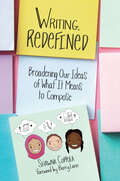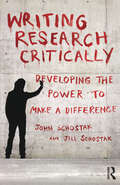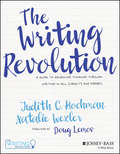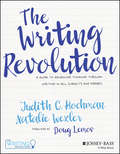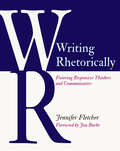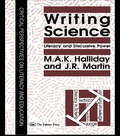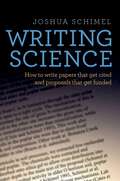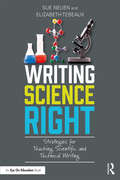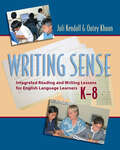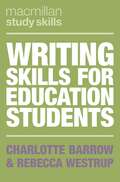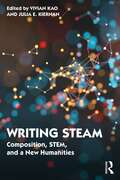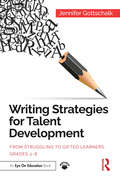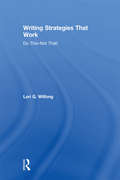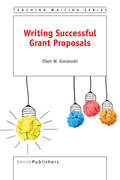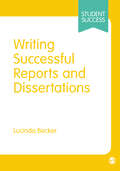- Table View
- List View
Writing, Redefined: Broadening Our Ideas of What It Means to Compose
by Shawna CoppolaWhat does it mean to write or to be a writer? In Shawna Coppola's book Writing, Redefined: Broadening Our Ideas of What It Means to Compose, she challenges the reader to expand beyond standard alphabetic writing and consider alternative forms of composition when assigning writing to students. This book empowers teachers to change what counts as writing in schools and classrooms, opening the door to students who may not consider themselves to be writers, but should and can. Inside you'll find alternative, engaging writing assignments that are visual, aural, or multimodal that will involve all students, specifically those: Who prefer to compose using a wider array of forms and modes For whom standard English is not the norm Who have been identified as dyslexic Whose cultural traditions lean heavily towards more aural forms of composition Who are considered struggling writers By finding ways to accommodate all styles of writers, students are free to unleash their creativity and share their story with others. While there is no question composition in written form is important and worth of study, broadening our definition of writing expands an enormous range of possibilities for composing for all students.
Writing Research Critically: Developing the power to make a difference
by John Schostak Jill SchostakThis is not a standard guide to writing a dissertation, thesis, project report, journal article or book. Rather, this book will help researchers who are dissatisfied with the typical recipe approaches to standardised forms of writing-up and want to explore how academic writing can be used to greater effect. Writing Research Critically shows that writing up is not just about ‘presenting findings’ as if the facts would speak for themselves. As the authors show there are certain vital skills that any writer needs to develop within their academic writing, such as the ability to: develop critical understanding and a personal academic voice question assumptions and the status quo frame the background and transgress the frame read between the lines when reviewing the literature strengthen interpretations and conctruct persuasive arguments challenge and develop theory and explanations develop ideas that create possibilities for realistic action Packed with examples from a range of writing projects (papers, dissertations, theses, reports, journal articles and books), this book provides a practical and refreshing way to approach and present research. Through case studies the authors offer a step-by-step guide from the early stages of planning a writing project, whether an undergraduate paper or a professional publication, to the polishing processes that make the difference between a merely descriptive account to an argument that intends to be critical and persuasive. Written in a clear accessible style this book will inspire a wide range of researchers from undergraduates to postgraduates, early career researchers and experienced professionals working across a wide range of fields, and demonstrate how research can have more impact in the real world.
Writing Research Critically: Developing the power to make a difference
by John Schostak Jill SchostakThis is not a standard guide to writing a dissertation, thesis, project report, journal article or book. Rather, this book will help researchers who are dissatisfied with the typical recipe approaches to standardised forms of writing-up and want to explore how academic writing can be used to greater effect. Writing Research Critically shows that writing up is not just about ‘presenting findings’ as if the facts would speak for themselves. As the authors show there are certain vital skills that any writer needs to develop within their academic writing, such as the ability to: develop critical understanding and a personal academic voice question assumptions and the status quo frame the background and transgress the frame read between the lines when reviewing the literature strengthen interpretations and conctruct persuasive arguments challenge and develop theory and explanations develop ideas that create possibilities for realistic action Packed with examples from a range of writing projects (papers, dissertations, theses, reports, journal articles and books), this book provides a practical and refreshing way to approach and present research. Through case studies the authors offer a step-by-step guide from the early stages of planning a writing project, whether an undergraduate paper or a professional publication, to the polishing processes that make the difference between a merely descriptive account to an argument that intends to be critical and persuasive. Written in a clear accessible style this book will inspire a wide range of researchers from undergraduates to postgraduates, early career researchers and experienced professionals working across a wide range of fields, and demonstrate how research can have more impact in the real world.
The Writing Revolution: A Guide to Advancing Thinking Through Writing in All Subjects and Grades
by Natalie Wexler Judith C. Hochman"HELP! My Students Can't Write!" Why You Need a Writing Revolution in Your Classroom and How to Lead It. The Writing Revolution (TWR) provides a clear method of instruction that you can use no matter what subject or grade level you teach. The model, also known as The Hochman Method, has demonstrated, over and over, that it can turn weak writers into strong communicators by focusing on specific techniques that match their needs and by providing them with targeted feedback. Insurmountable as the challenges faced by many students may seem, TWR can make a dramatic difference. And the method does more than improve writing skills. It also helps: Boost reading comprehension Improve organizational and study skills Enhance speaking abilities Develop analytical capabilities TWR is as much a method of teaching content as it is a method of teaching writing. There's no separate writing block and no separate writing curriculum. Instead, teachers of all subjects adapt the TWR strategies and activities to their current curriculum and weave them into their content instruction. But perhaps what's most revolutionary about the TWR method is that it takes the mystery out of learning to write well. It breaks the writing process down into manageable chunks and then has students practice the chunks they need, repeatedly, while also learning content.
The Writing Revolution: A Guide to Advancing Thinking Through Writing in All Subjects and Grades
by Natalie Wexler Judith C. Hochman"HELP! My Students Can't Write!" Why You Need a Writing Revolution in Your Classroom and How to Lead It. The Writing Revolution (TWR) provides a clear method of instruction that you can use no matter what subject or grade level you teach. The model, also known as The Hochman Method, has demonstrated, over and over, that it can turn weak writers into strong communicators by focusing on specific techniques that match their needs and by providing them with targeted feedback. Insurmountable as the challenges faced by many students may seem, TWR can make a dramatic difference. And the method does more than improve writing skills. It also helps: Boost reading comprehension Improve organizational and study skills Enhance speaking abilities Develop analytical capabilities TWR is as much a method of teaching content as it is a method of teaching writing. There's no separate writing block and no separate writing curriculum. Instead, teachers of all subjects adapt the TWR strategies and activities to their current curriculum and weave them into their content instruction. But perhaps what's most revolutionary about the TWR method is that it takes the mystery out of learning to write well. It breaks the writing process down into manageable chunks and then has students practice the chunks they need, repeatedly, while also learning content.
Writing Rhetorically: Fostering Responsive Thinkers and Communicators
by Jennifer FletcherWriting Rhetorically: Fostering Responsive Thinkers and Communicators, author Jennifer Fletcher aims to cultivate independent learners through rhetorical thinking. She provides teachers with strategies and frameworks for writing instruction that can be applied across multiple subjects and lesson plans. Students learn to discover their own questions, design their own inquiry process, develop their own positions and purposes, make their own choices about content and form, and contribute to conversations that matter to them. Inside this book, Fletcher helps remove some of the scaffolding and explains how to put in practice some methods which can successfully foster: Inquiry, Invention, and Rhetorical Thinking Writing for Transfer Paraphrasing, Summary, Synthesis, and Citation Skills Research Skills and Processes Evidence-Based Reasoning Rhetorical Decision Making' Rhetorical decision making helps students develop the skills, knowledge, and mindsets needed for transfer of learning: the ability to adapt and apply learning in new settings. The more choices students make as writers, the better prepared they are to analyze and respond to diverse rhetorical situations.' Writing Rhetorically' shows teachers what it looks like to dig into real texts with students and novice writers and how it develops them for lifelong learning.
Writing Rhetorically: Fostering Responsive Thinkers and Communicators
by Jennifer FletcherWriting Rhetorically: Fostering Responsive Thinkers and Communicators, author Jennifer Fletcher aims to cultivate independent learners through rhetorical thinking. She provides teachers with strategies and frameworks for writing instruction that can be applied across multiple subjects and lesson plans. Students learn to discover their own questions, design their own inquiry process, develop their own positions and purposes, make their own choices about content and form, and contribute to conversations that matter to them. Inside this book, Fletcher helps remove some of the scaffolding and explains how to put in practice some methods which can successfully foster: Inquiry, Invention, and Rhetorical Thinking Writing for Transfer Paraphrasing, Summary, Synthesis, and Citation Skills Research Skills and Processes Evidence-Based Reasoning Rhetorical Decision Making' Rhetorical decision making helps students develop the skills, knowledge, and mindsets needed for transfer of learning: the ability to adapt and apply learning in new settings. The more choices students make as writers, the better prepared they are to analyze and respond to diverse rhetorical situations.' Writing Rhetorically' shows teachers what it looks like to dig into real texts with students and novice writers and how it develops them for lifelong learning.
Writing Science: Literacy And Discursive Power (Pitt Comp Literacy Culture Ser.)
by M.A.K. Halliday J.R. MartinThis book is about the use of language in the science classroom. It discusses the evolution of scientific discourse for learning in secondary schools, and examines the form and function of language across a variety of levels including lexiogrammar, discourse semantics, register, genre and ideology. Special attention is paid to how this knowledge is imparted. It will be of particular interest to educators involved with linguistics and/or science curriculum and teachers of English for special and academic purposes.; It is aimed at teachers of undergraduates in science and literacy, linguists teaching in English for special and academic purposes and students in higher education with an interest in science and literacy.
Writing Science: Literacy And Discursive Power
by M.A.K. Halliday J.R. MartinThis book is about the use of language in the science classroom. It discusses the evolution of scientific discourse for learning in secondary schools, and examines the form and function of language across a variety of levels including lexiogrammar, discourse semantics, register, genre and ideology. Special attention is paid to how this knowledge is imparted. It will be of particular interest to educators involved with linguistics and/or science curriculum and teachers of English for special and academic purposes.; It is aimed at teachers of undergraduates in science and literacy, linguists teaching in English for special and academic purposes and students in higher education with an interest in science and literacy.
Writing Science: How to Write Papers That Get Cited and Proposals That Get Funded
by Joshua SchimelAs a scientist, you are a professional writer: your career is built on successful proposals and papers. Success isn't defined by getting papers into print, but by getting them into the reader's consciousness. Writing Science is built upon the idea that successful science writing tells a story. It uses that insight to discuss how to write more effectively. Integrating lessons from other genres of writing with those from the author's years of experience as author, reviewer, and editor, the book shows scientists and students how to present their research in a way that is clear and that will maximize reader comprehension. The book takes an integrated approach, using the principles of story structure to discuss every aspect of successful science writing, from the overall structure of a paper or proposal to individual sections, paragraphs, sentences, and words. It begins by building core arguments, analyzing why some stories are engaging and memorable while others are quickly forgotten, and proceeds to the elements of story structure, showing how the structures scientists and researchers use in papers and proposals fit into classical models. The book targets the internal structure of a paper, explaining how to write clear and professional sections, paragraphs, and sentences in a way that is clear and compelling. The ideas within a paper should flow seamlessly, drawing readers along. The final section of the book deals with special challenges, such as how to discuss research limitations and how to write for the public. Writing Science is a much-needed guide to succeeding in modern science. Its insights and strategies will equip science students, scientists, and professionals across a wide range of scientific and technical fields with the tools needed to communicate effectively.
Writing Science: How to Write Papers That Get Cited and Proposals That Get Funded
by Joshua SchimelAs a scientist, you are a professional writer: your career is built on successful proposals and papers. Success isn't defined by getting papers into print, but by getting them into the reader's consciousness. Writing Science is built upon the idea that successful science writing tells a story. It uses that insight to discuss how to write more effectively. Integrating lessons from other genres of writing with those from the author's years of experience as author, reviewer, and editor, the book shows scientists and students how to present their research in a way that is clear and that will maximize reader comprehension. The book takes an integrated approach, using the principles of story structure to discuss every aspect of successful science writing, from the overall structure of a paper or proposal to individual sections, paragraphs, sentences, and words. It begins by building core arguments, analyzing why some stories are engaging and memorable while others are quickly forgotten, and proceeds to the elements of story structure, showing how the structures scientists and researchers use in papers and proposals fit into classical models. The book targets the internal structure of a paper, explaining how to write clear and professional sections, paragraphs, and sentences in a way that is clear and compelling. The ideas within a paper should flow seamlessly, drawing readers along. The final section of the book deals with special challenges, such as how to discuss research limitations and how to write for the public. Writing Science is a much-needed guide to succeeding in modern science. Its insights and strategies will equip science students, scientists, and professionals across a wide range of scientific and technical fields with the tools needed to communicate effectively.
Writing Science Right: Strategies for Teaching Scientific and Technical Writing
by Sue Neuen Elizabeth TebeauxHelp your students improve their science understanding and communicate their knowledge more effectively. Writing Science Right shows you the best ways to teach content-area writing so that students can share their learning and discoveries through informal and formal writing assignments and oral presentations. You’ll teach students how to… identify their audience and an appropriate organizational structure for their writing; achieve a readable style by knowing the reader’s background knowledge; build effective sentences and concise paragraphs; prepare and deliver oral presentations that bring content to life; use major science articles, abstracts, and summaries as mentor texts; and more! Throughout the book, you’ll find a wide variety of sample articles and suggested assignments that you can use immediately. In addition, a list of additional teaching texts and resources is available on the Routledge website at www.routledge.com/9781138302679.
Writing Science Right: Strategies for Teaching Scientific and Technical Writing
by Sue Neuen Elizabeth TebeauxHelp your students improve their science understanding and communicate their knowledge more effectively. Writing Science Right shows you the best ways to teach content-area writing so that students can share their learning and discoveries through informal and formal writing assignments and oral presentations. You’ll teach students how to… identify their audience and an appropriate organizational structure for their writing; achieve a readable style by knowing the reader’s background knowledge; build effective sentences and concise paragraphs; prepare and deliver oral presentations that bring content to life; use major science articles, abstracts, and summaries as mentor texts; and more! Throughout the book, you’ll find a wide variety of sample articles and suggested assignments that you can use immediately. In addition, a list of additional teaching texts and resources is available on the Routledge website at www.routledge.com/9781138302679.
Writing Sense: Integrated Reading and Writing Lessons for English Language Learners
by Juli Kendall Outey KhuonWriting is all about making meaning. The prospect of teaching writing to a classroom full of students—some who speak English and some who don't, can be overwhelming. When students learning English are at different levels, the task is even more challenging. Writing Sense: Integrated Reading and Writing Lessons for English Language Learners outlines the classroom conditions necessary for successful writing instruction with English language learners, whether in writing workshop and/or small-group instruction. It includes 68 classroom-tested lessons for grades K 8 that show kids at all levels of language acquisition how to make connections, ask questions, visualize (make mental images), infer, determine importance, synthesize, monitor meaning and comprehension, and use fix-up strategies. The five main sections are geared to the stages of language proficiency, and lessons are divided into younger and older students, spanning kindergarten through to grade eight. There are extensive lists of suggested books for mentor texts as well as lists of mentor authors to facilitate teachers' planning and instruction.
Writing Sense: Integrated Reading and Writing Lessons for English Language Learners
by Juli Kendall Outey KhuonWriting is all about making meaning. The prospect of teaching writing to a classroom full of students—some who speak English and some who don't, can be overwhelming. When students learning English are at different levels, the task is even more challenging. Writing Sense: Integrated Reading and Writing Lessons for English Language Learners outlines the classroom conditions necessary for successful writing instruction with English language learners, whether in writing workshop and/or small-group instruction. It includes 68 classroom-tested lessons for grades K 8 that show kids at all levels of language acquisition how to make connections, ask questions, visualize (make mental images), infer, determine importance, synthesize, monitor meaning and comprehension, and use fix-up strategies. The five main sections are geared to the stages of language proficiency, and lessons are divided into younger and older students, spanning kindergarten through to grade eight. There are extensive lists of suggested books for mentor texts as well as lists of mentor authors to facilitate teachers' planning and instruction.
Writing Skills for Education Students
by Rebecca Westrup Charlotte BarrowThis concise text will help your students get to grips with the core academic skills they need to succeed at written assignments, including critical thinking, reading, note-making and assignment planning. It also equips students with practical strategies for reflecting on their learning and placement experiences and using observational data from their placements in written assignments. Chapters incorporate subject-specific examples and activities, which make it easier for students to develop these skills and apply them to their own work.This engaging book will be an essential companion for all students of Education, Childhood Studies and related disciplines.
Writing STEAM: Composition, STEM, and a New Humanities
by Vivian KaoThis edited collection positions writing at the center of interdisciplinary higher education, and explores how writing instruction, writing scholarship, and writing program administration bring STEM and the humanities together in meaningful, creative, and beneficial ways.Writing professionals are at the forefront of a cross-pollination between STEM (Science, Technology, Engineering, and Mathematics) and the arts and humanities. In their work as educators, scholars, and administrators, they collaborate with colleagues in engineering, scientific, technical, and health disciplines, offer new degree programs that allow students to bring the humanities to bear on design experiments, and build an academic culture that promotes a vision of the humanities in the twenty-first century, as well as a vision of technology that is decidedly human. This collection surveys and promotes that work through chapters focused on writing instruction, writing scholarship, and writing program administration, covering topics that include data-driven writing courses, public science communication, non-traditional college students, creative writing, gamification, skills transfer, and Writing Across the Curriculum programs. Writing STEAM will be essential reading for scholars, instructors, and administrators in writing studies, rhetoric and composition, STEM, and a variety of interdisciplinary programs; it will aid in teacher training for both humanities and STEM courses focused on writing and communication.
Writing STEAM: Composition, STEM, and a New Humanities
by Vivian Kao Julia KiernanThis edited collection positions writing at the center of interdisciplinary higher education, and explores how writing instruction, writing scholarship, and writing program administration bring STEM and the humanities together in meaningful, creative, and beneficial ways.Writing professionals are at the forefront of a cross-pollination between STEM (Science, Technology, Engineering, and Mathematics) and the arts and humanities. In their work as educators, scholars, and administrators, they collaborate with colleagues in engineering, scientific, technical, and health disciplines, offer new degree programs that allow students to bring the humanities to bear on design experiments, and build an academic culture that promotes a vision of the humanities in the twenty-first century, as well as a vision of technology that is decidedly human. This collection surveys and promotes that work through chapters focused on writing instruction, writing scholarship, and writing program administration, covering topics that include data-driven writing courses, public science communication, non-traditional college students, creative writing, gamification, skills transfer, and Writing Across the Curriculum programs. Writing STEAM will be essential reading for scholars, instructors, and administrators in writing studies, rhetoric and composition, STEM, and a variety of interdisciplinary programs; it will aid in teacher training for both humanities and STEM courses focused on writing and communication.
Writing Strategies for Talent Development: From Struggling to Gifted Learners, Grades 3–8
by Jennifer GottschalkWriting Strategies for Talent Development helps educators incorporate effective and engaging writing strategies into their classroom that are designed to reach struggling and gifted students alike. This guide demonstrates how teachers can provide the means to write (with appropriate tools and classroom structures), the motivation to write (through engaging genre-based lessons), and the opportunity to write more frequently across multiple subjects. Covering genres from fantasy, crime, and humor, to horror, non-fiction, and even romance, this book provides the tools to support every writer in the room.
Writing Strategies for Talent Development: From Struggling to Gifted Learners, Grades 3–8
by Jennifer GottschalkWriting Strategies for Talent Development helps educators incorporate effective and engaging writing strategies into their classroom that are designed to reach struggling and gifted students alike. This guide demonstrates how teachers can provide the means to write (with appropriate tools and classroom structures), the motivation to write (through engaging genre-based lessons), and the opportunity to write more frequently across multiple subjects. Covering genres from fantasy, crime, and humor, to horror, non-fiction, and even romance, this book provides the tools to support every writer in the room.
Writing Strategies That Work: Do This--Not That!
by Lori G. WilfongLearn the ten keys to effective writing instruction! In this dynamic book, bestselling author Lori G. Wilfong takes you through today’s best practices for teaching writing and how to implement them in the classroom. She also points out practices that should be avoided, helping you figure out how to update your teaching so that all students can reach success. You’ll discover how to… Make sure students have enough work in a genre before you assign writing Develop thoughtful, short writing prompts that are "infinite" and not finite Have students read and learn from master authors in the genre they are writing Create a writing community so that writing is not an isolated activity Use anchor charts and minilessons, along with rubrics and checklists Implement revising strategies, not just editing strategies, taught in context Use conferencing to grow students as thoughtful, reflective writers Let narratives be personal and creative, focusing on details and imagery Let informational writing explore a topic creatively and in depth Let argument writing be situated in real-world application and not be limited to one-sided, "what-if" debates Every chapter begins with an engaging scenario, includes the "why" behind the practice and how it connects to the Common Core, and clearly describes how implement the strategy. The book also contains tons of handy templates that you can reproduce and use in your own classroom. You can photocopy these templates or download them from our website at http://www.routledge.com/books/details/9781138812444.
Writing Strategies That Work: Do This--Not That!
by Lori G. WilfongLearn the ten keys to effective writing instruction! In this dynamic book, bestselling author Lori G. Wilfong takes you through today’s best practices for teaching writing and how to implement them in the classroom. She also points out practices that should be avoided, helping you figure out how to update your teaching so that all students can reach success. You’ll discover how to… Make sure students have enough work in a genre before you assign writing Develop thoughtful, short writing prompts that are "infinite" and not finite Have students read and learn from master authors in the genre they are writing Create a writing community so that writing is not an isolated activity Use anchor charts and minilessons, along with rubrics and checklists Implement revising strategies, not just editing strategies, taught in context Use conferencing to grow students as thoughtful, reflective writers Let narratives be personal and creative, focusing on details and imagery Let informational writing explore a topic creatively and in depth Let argument writing be situated in real-world application and not be limited to one-sided, "what-if" debates Every chapter begins with an engaging scenario, includes the "why" behind the practice and how it connects to the Common Core, and clearly describes how implement the strategy. The book also contains tons of handy templates that you can reproduce and use in your own classroom. You can photocopy these templates or download them from our website at http://www.routledge.com/books/details/9781138812444.
Writing Successful Grant Proposals (Teaching Writing)
by Ellen W. GorsevskiThe Teaching Writing series publishes user-friendly writing guides penned by authors with publishing records in their subject matter. Most grants books—often hundreds of pages long—make grant writing seem too intimidating, but Gorsevski gets to the heart of the process. In simple steps, Writing Successful Grant Proposals highlights key things savvy proposal writers do to attract and secure prospective funders. With clear, concise instructions, this book demystifies grant proposal writing, from the initial development phase, to the writing and submissions phase, to the grant award phase, to the final delivery of project results phase. This small but mighty guide shares with readers effective strategies for adapting proposals to meet diversity, digital, and other evolving 21st Century constraints of grant review, offering pointers for staying on-task, getting the proposed project done on time and under budget, plus many other insider tips for smoothly navigating through the grants process. This handy guidebook is designed to help academics, non-profits, ‘creatives,’ and entrepreneurs to write successful grant proposals.“This little book gets quickly to the important points. Even better, Dr. Gorsevski has been around the grant-writing block a few times herself. She's giving honest answers and pragmatic advice. This is all the stuff you really need to know!” – Dale Cyphert, Ph.D., Associate Professor of Management, College of Business Administration, University of Northern Iowa“Finally! A savvy book on grants that speaks to large social concerns of peace, environment, justice and multiple audiences. Gorsevski's book is a much needed resource for agency, academic and volunteer leaders alike regarding the do's and don'ts of dealing with diverse donors and RFPs.” – George A. Lopez, Hesburgh Professor of Peace Studies Emeritus, University of Notre Dame, and former Vice-President of the US Institute of PeaceEllen W. Gorsevski, Ph.D., shares her experience in writing successful grant proposals in private sector think tanks and contracting firms and in public sector teaching and research. She is author of books on persuasive communication, including Peaceful Persuasion: The Geopolitics of Nonviolent Rhetoric (SUNY Press, 2004) and Dangerous Women: The Rhetoric of the Women Nobel Peace Laureates (Troubador Publishing, Ltd, 2014).
Writing Successful Reports and Dissertations (Student Success)
by Lucinda BeckerAre you unsure what your report should look like or how you’ll ever finish it in time? Are you freaking out about starting on an extended piece of writing? Help is here! In this handy little book, you’ll find expert guidance to enable you to produce a successful report or dissertation. With a focus on developing an effective writing style and argument, this book shows you, step-by-step, how to plan and deliver a perfect piece of writing to gain top marks. Open up to find advice on: What makes dissertations and reports distinctive Organising your time and materials Finding the right planning method for you How to structure your writing successfully Writing good sentences, paragraphs, sections and chapters. Read this book and you’re on your way to writing a great report or dissertation! The Student Success series are essential guides for students of all levels. From how to think critically and write great essays to planning your dream career, the Student Success series helps you study smarter and get the best from your time at university. Visit the SAGE Study Skills hub for tips and resources for study success!
Writing Successful Reports and Dissertations (Student Success)
by Lucinda BeckerAre you unsure what your report should look like or how you’ll ever finish it in time? Are you freaking out about starting on an extended piece of writing? Help is here! In this handy little book, you’ll find expert guidance to enable you to produce a successful report or dissertation. With a focus on developing an effective writing style and argument, this book shows you, step-by-step, how to plan and deliver a perfect piece of writing to gain top marks. Open up to find advice on: What makes dissertations and reports distinctive Organising your time and materials Finding the right planning method for you How to structure your writing successfully Writing good sentences, paragraphs, sections and chapters. Read this book and you’re on your way to writing a great report or dissertation! The Student Success series are essential guides for students of all levels. From how to think critically and write great essays to planning your dream career, the Student Success series helps you study smarter and get the best from your time at university. Visit the SAGE Study Skills hub for tips and resources for study success!
